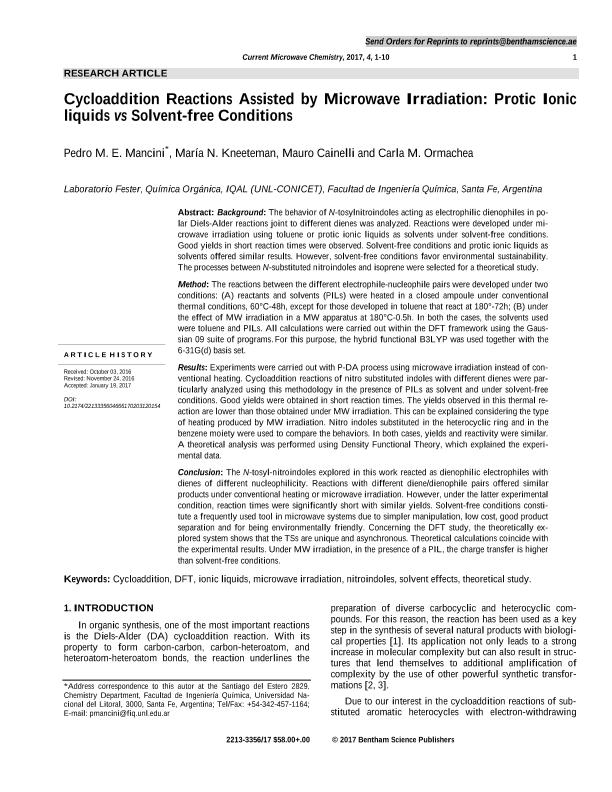Mostrar el registro sencillo del ítem
dc.contributor.author
Mancini, Pedro Maximo Emilio

dc.contributor.author
Kneeteman, Maria Nelida

dc.contributor.author
Cainelli, Mauro

dc.contributor.author
Ormachea, Carla

dc.date.available
2018-12-19T15:28:10Z
dc.date.issued
2017-09
dc.identifier.citation
Mancini, Pedro Maximo Emilio; Kneeteman, Maria Nelida; Cainelli, Mauro; Ormachea, Carla; Cycloaddition Reactions Assisted by Microwave Irradiation: Protic Ionic liquids vs Solvent-free Conditions; Betham; Current Microwave Chemistry; 4; 3; 9-2017; 219-228
dc.identifier.issn
2213-3356
dc.identifier.uri
http://hdl.handle.net/11336/66746
dc.description.abstract
Background: The behavior of N-tosylnitroindoles acting as electrophilic dienophiles in polar Diels-Alder reactions joint to different dienes was analyzed. Reactions were developed under microwave irradiation using toluene or protic ionic liquids as solvents under solvent-free conditions. Good yields in short reaction times were observed. Solvent-free conditions and protic ionic liquids as solvents offered similar results. However, solvent-free conditions favor environmental sustainability. The processes between N-substituted nitroindoles and isoprene were selected for a theoretical study.Method: The reactions between the different electrophile-nucleophile pairs were developed under two conditions: (A) reactants and solvents (PILs) were heated in a closed ampoule under conventional thermal conditions, 60°C-48h, except for those developed in toluene that react at 180°-72h; (B) under the effect of MW irradiation in a MW apparatus at 180°C-0.5h. In both the cases, the solvents used were toluene and PILs. All calculations were carried out within the DFT framework using the Gaussian 09 suite of programs. For this purpose, the hybrid functional B3LYP was used together with the 6-31G(d) basis set.Results: Experiments were carried out with P-DA process using microwave irradiation instead of conventional heating. Cycloaddition reactions of nitro substituted indoles with different dienes were particularly analyzed using this methodology in the presence of PILs as solvent and under solvent-free conditions. Good yields were obtained in short reaction times. The yields observed in this thermal reaction are lower than those obtained under MW irradiation. This can be explained considering the type of heating produced by MW irradiation. Nitro indoles substituted in the heterocyclic ring and in the benzene moiety were used to compare the behaviors. In both cases, yields and reactivity were similar. A theoretical analysis was performed using Density Functional Theory, which explained the experimental data.Conclusion: The N-tosyl-nitroindoles explored in this work reacted as dienophilic electrophiles with dienes of different nucleophilicity. Reactions with different diene/dienophile pairs offered similar products under conventional heating or microwave irradiation. However, under the latter experimental condition, reaction times were significantly short with similar yields. Solvent-free conditions constitute a frequently used tool in microwave systems due to simpler manipulation, low cost, good product separation and for being environmentally friendly. Concerning the DFT study, the theoretically explored system shows that the TSs are unique and asynchronous. Theoretical calculations coincide with the experimental results. Under MW irradiation, in the presence of a PIL, the charge transfer is higher than solvent-free conditions.
dc.format
application/pdf
dc.language.iso
eng
dc.publisher
Betham
dc.rights
info:eu-repo/semantics/openAccess
dc.rights.uri
https://creativecommons.org/licenses/by-nc-sa/2.5/ar/
dc.subject
Nitroindoles
dc.subject
Microwave Irradiation
dc.subject
Solvent Effects
dc.subject
Dft
dc.subject
Cycloaddition
dc.subject
Ionic Liquids
dc.subject
Theoretical Study
dc.subject.classification
Otras Ciencias Químicas

dc.subject.classification
Ciencias Químicas

dc.subject.classification
CIENCIAS NATURALES Y EXACTAS

dc.title
Cycloaddition Reactions Assisted by Microwave Irradiation: Protic Ionic liquids vs Solvent-free Conditions
dc.type
info:eu-repo/semantics/article
dc.type
info:ar-repo/semantics/artículo
dc.type
info:eu-repo/semantics/publishedVersion
dc.date.updated
2018-12-03T13:12:56Z
dc.journal.volume
4
dc.journal.number
3
dc.journal.pagination
219-228
dc.journal.pais
Pakistán

dc.description.fil
Fil: Mancini, Pedro Maximo Emilio. Universidad Nacional del Litoral. Instituto de Química Aplicada del Litoral. Consejo Nacional de Investigaciones Científicas y Técnicas. Centro Científico Tecnológico Conicet - Santa Fe. Instituto de Química Aplicada del Litoral.; Argentina
dc.description.fil
Fil: Kneeteman, Maria Nelida. Universidad Nacional del Litoral. Instituto de Química Aplicada del Litoral. Consejo Nacional de Investigaciones Científicas y Técnicas. Centro Científico Tecnológico Conicet - Santa Fe. Instituto de Química Aplicada del Litoral.; Argentina
dc.description.fil
Fil: Cainelli, Mauro. Universidad Nacional del Litoral. Instituto de Química Aplicada del Litoral. Consejo Nacional de Investigaciones Científicas y Técnicas. Centro Científico Tecnológico Conicet - Santa Fe. Instituto de Química Aplicada del Litoral.; Argentina
dc.description.fil
Fil: Ormachea, Carla. Universidad Nacional del Litoral. Instituto de Química Aplicada del Litoral. Consejo Nacional de Investigaciones Científicas y Técnicas. Centro Científico Tecnológico Conicet - Santa Fe. Instituto de Química Aplicada del Litoral.; Argentina
dc.journal.title
Current Microwave Chemistry
dc.relation.alternativeid
info:eu-repo/semantics/altIdentifier/doi/https://dx.doi.org/10.2174/2213335604666170203120154
dc.relation.alternativeid
info:eu-repo/semantics/altIdentifier/url/http://www.eurekaselect.com/149742/article
Archivos asociados
